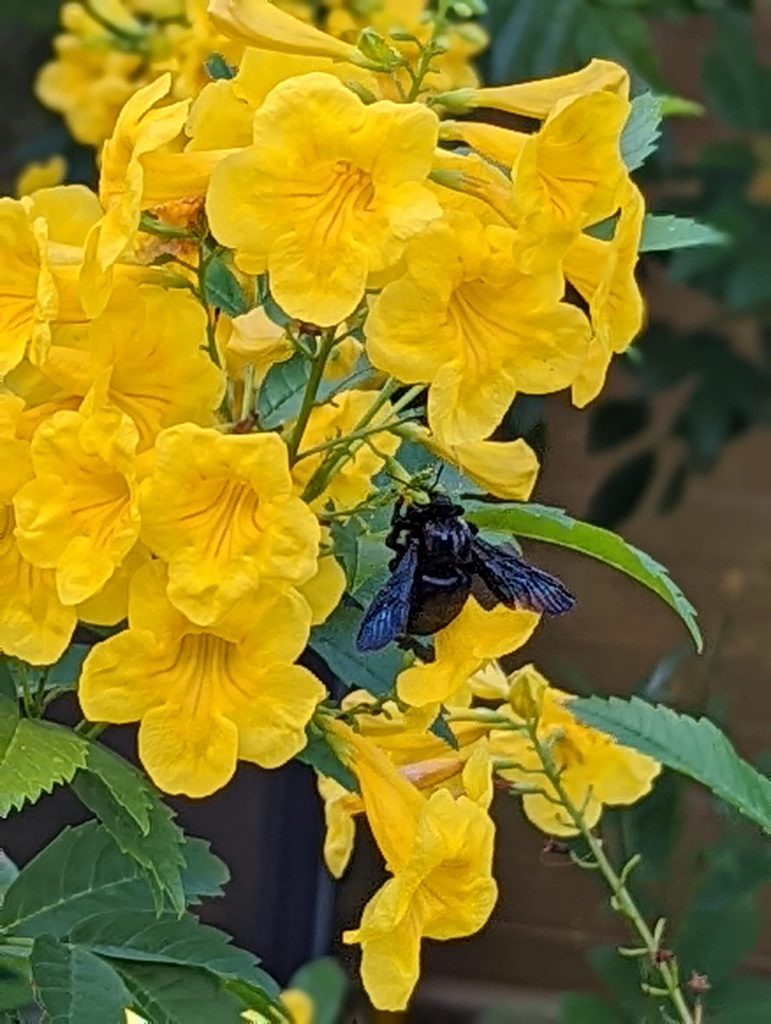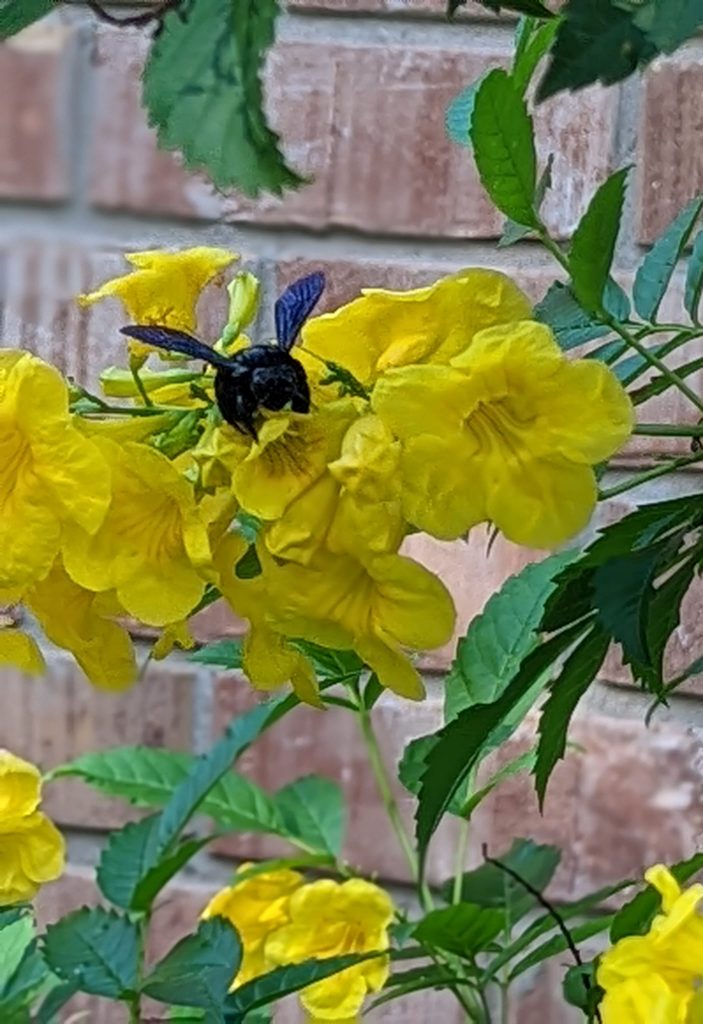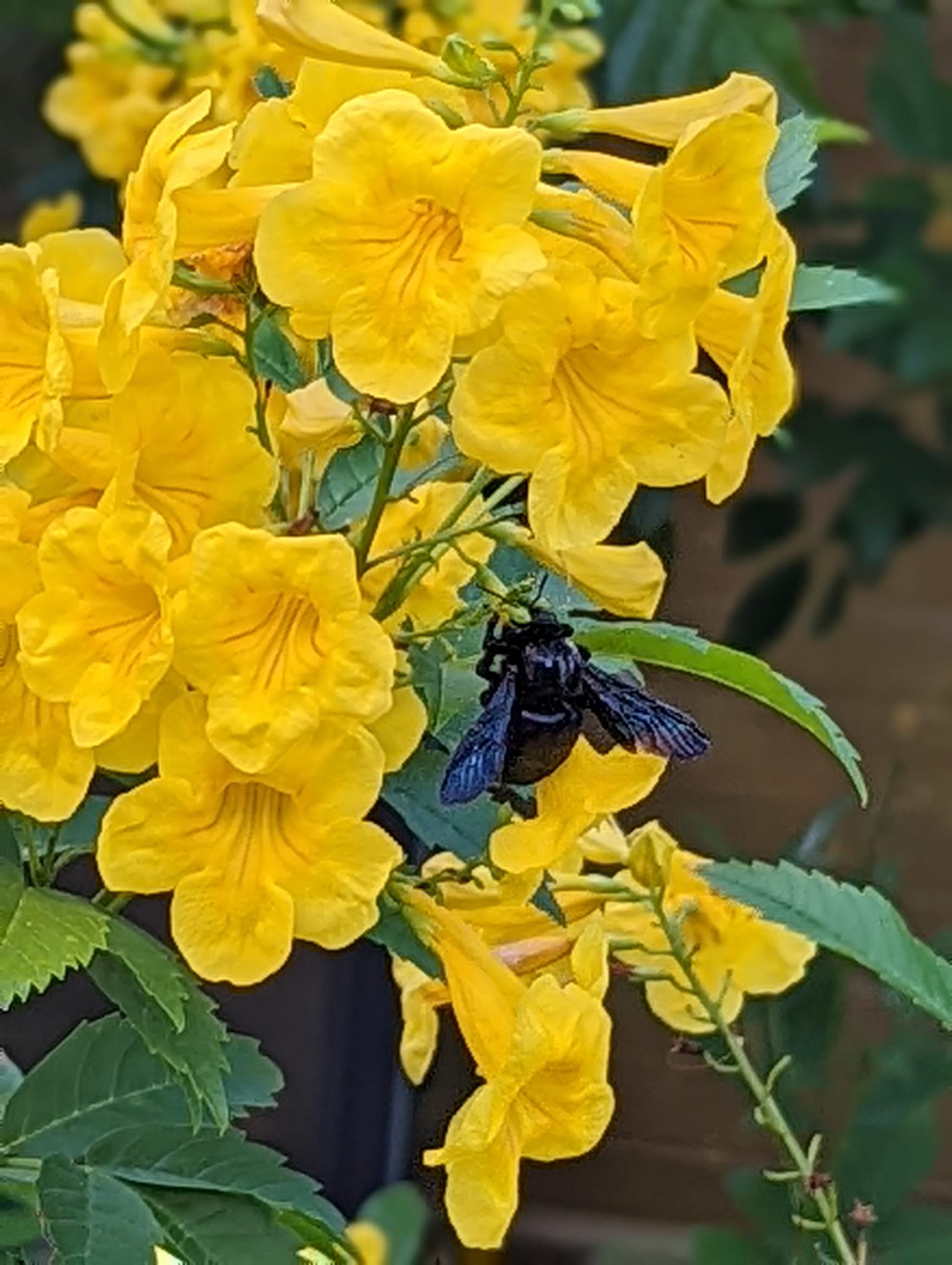by M. Kathy Raines
Bzzzzz! scolded a plump black bee, swooping and darting at me as I hacked at the last stump of an unwanted bougainvillea. Yikes! I sped off, fearing it was a member of a gang of killer bees.
Gingerly, I returned—spying no evidence of its cohorts— and inspected a tidy, round hole it had hovered around—that is, till it again rushed at me, sending me packing. Curious, though, and set on completing my task, I returned and snapped its photo, which I sent to the iNaturalist app. It was a large carpenter bee, I learned—likely a stingless male guarding the entrance to the female’s woody nest from invasive insects and, well, me.
Even the armed female rarely stings people. Unlike the honeybee, which dies when its barbed stinger detaches, embedding itself into human skin, a carpenter bee, with its smooth, removable stinger, lives on. Knowing the male to be harmless, some people appreciate this fierce little sentry’s propensity for shooing off irksome insects.
Unlike honeybees or bumblebees, these generally solitary creatures have no hives, colonies or queens. Also, each female can breed.

People often mistake carpenter bees for similarly hefty bumblebees. The carpenter bee, though, appears alone or with a few of its fellows. Also, it has a shiny, not very hairy abdomen, but a hairy thorax. The carpenter’s head—which contains strong jaws for chewing wood—is particularly large and bulbous. The males of many species have notable, colorful facial markings.
Large carpenter bees are in the genus Xylocopa, which is Greek for “wood worker”. Their various species inhabit much of the U.S., particularly the South and East, and they’re quite well-represented hereabouts. The National Butterfly Center in Mission, Texas, reports four species: the southern carpenter bee (Xylocopa micans); Griswold’s (Xylocopa griswoldi); Strand’s (Xylocopa strandi) and Parkinsonia (Xylocopa parkinsoniae). The following link to the Center provides superb photos and descriptions of both large and small carpenter bees:
https://www.wildbeestexas.com/carpenter-bees-xylocopa-ceratina.
Like other bees, carpenters feed on nectar and pollen and, while doing so, transfer pollen from a flower’s male anther to the same flower’s, or another’s, stigma, thus enabling the plant’s reproduction. Carpenter bees and bumblebees, unlike honeybees, engage in highly effective “buzz pollination” in which they vibrate flight muscles as they grasp flowers, thus, effectively shaking off pollen.
A carpenter bee may disrupt successful pollination, however, through its habit of “nectar robbing”: lacking a sufficiently long tongue to access nectar from a deep, tubular flower, it may carve an opening in its base to conveniently lap up nectar. In doing so, it may bypass pollen and, providing this accessible hole, encourage other insects to do so. Some insects may even shun the slit blossoms. Some evidence suggests, however, that the available tear may increase insect pollination, with smaller bees making multiple pollen-gathering trips.
Carpenter bees, unlike termites, do not eat wood. A female, with her powerful mandibles, bores an entrance hole, then turns and excavates one or more approximately four-inch nesting galleries, which are used by one or a few bees. She then collects a mixture of nectar and pollen, or “bee bread”, for larvae, depositing her first pile at the tunnels’s end and laying one egg on each. Then, between each cell, she erects a wall of chewed wood, repeating the procedure till she has created from six to nine of them. The nesting gallery, as revealed by X-rays and opened wood, resembles a set of railroad cars. Bees may also reuse tunnels. The following video shows this quite clearly:
https://www.youtube.com/watch?v=i-TGT0Y22vQ.
The white larvae hatch, eat their provisions, then enter a pupal stage. Sometimes, though, a tiger bee fly (Xenox tigrinus) will lay its eggs at a nest entrance, and the resulting larvae consume those of its unwitting host.
Adult carpenter bees emerge to forage and mate, continuing to sleep in their tunnels at night. Some bees hibernate there, but those living in the subtropics may remain active during winters.

Though carpenter bees nest in soft and rotting limbs, they also do so in wooden structures, sometimes damaging them, but not as seriously as termites. Still, ads for exterminators pop up immediately during an online search. While determining how best to preserve our constructions, biologists strive to protect these, as well as other valuable pollinators. Carpenter bees do avoid nesting in painted wood, and wood sealants deter them temporarily.
I now delight in watching these beneficial, harmless bees buzzing noisily, feeding and pollinating my esperanza shrubs. I must paint my fence, though.


Leave a Reply